E-auction 80-39694 - brm_182033 - CONSTANTINE II Centenionalis ou nummus
You must signin and be an approved bidder to bid, LOGIN TO BID. Accounts are subject to approval and the approval process takes place within 48 hours. Do not wait until the day a sale closes to register. Clicking on « bid » constitutes acceptance of the terms of use of cgb.fr private e-auctions.
Bids must be placed in whole Euro amounts only. The sale will start closing at the time stated on the item description; any bids received at the site after the closing time will not be executed. Transmission times may vary and bids could be rejected if you wait until the last second. For further information ckeck the E-auctions F.A.Q.
NO BUYER'S FEE.
NO BUYER'S FEE.
| Estimate : | 25 € |
| Price : | 11 € |
| Maximum bid : | 11 € |
| End of the sale : | 27 October 2014 15:26:30 |
| bidders : | 3 bidders |
Type : Centenionalis ou nummus
Date: 321
Mint name / Town : Lyon
Metal : copper
Diameter : 20,5 mm
Orientation dies : 12 h.
Weight : 2,39 g.
Coments on the condition:
Exemplaire sur un flan extrêmement large, bien centré des deux côtés, les grènetis visibles. Beau petit portrait. Revers bien venu à la frappe. Usure importante, mais parfaitement lisible et identifiable. Patine vert foncé granuleuse
Catalogue references :
Obverse
Obverse legend : CONSTANTINVS IVN N C.
Obverse description : Buste lauré, drapé et cuirassé de Constantin II césar à droite, vu de trois quarts en arrière (A*2).
Obverse translation : “Constantinus Iunior Nobilissimus Cæsar”, (Constantin le jeune très noble césar).
Reverse
Reverse legend : BEATA TRANQVILLITAS/ VO/ TIS/ XX/ C|R// PLG.
Reverse description : Autel sur la face antérieure duquel on lit VO/ TIS/ XX en trois lignes ; sur l’autel, un globe divisé en quatre parties ; au-dessus, trois étoiles.
Reverse translation : “Beata Tranquillitas/ Votis vicennalibus”, (L’heureuse Tranquillité/ Vœux pour le vingtième année de règne).
Commentary
Poids très léger. Rubans de type 3. La cuirasse est à peine visible sous le paludamentum. En revanche la fibule d’attache du même paludamentum est bien visible. Au revers, les lettres dans le champ C|R pourraient être les initiales de “Claritas Reipublicæ” pour l’éclat de la République.








 Report a mistake
Report a mistake Print the page
Print the page Share my selection
Share my selection Ask a question
Ask a question Consign / sell
Consign / sell
 Full data
Full data















